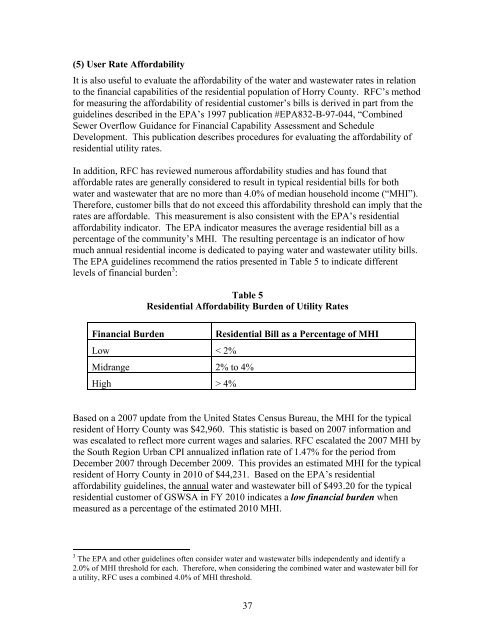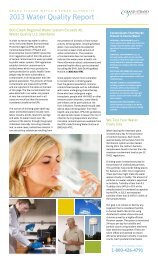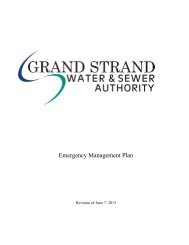2030 Plan - Grand Strand Water and Sewer Authority
2030 Plan - Grand Strand Water and Sewer Authority
2030 Plan - Grand Strand Water and Sewer Authority
Create successful ePaper yourself
Turn your PDF publications into a flip-book with our unique Google optimized e-Paper software.
(5) User Rate Affordability<br />
It is also useful to evaluate the affordability of the water <strong>and</strong> wastewater rates in relation<br />
to the financial capabilities of the residential population of Horry County. RFC’s method<br />
for measuring the affordability of residential customer’s bills is derived in part from the<br />
guidelines described in the EPA’s 1997 publication #EPA832-B-97-044, “Combined<br />
<strong>Sewer</strong> Overflow Guidance for Financial Capability Assessment <strong>and</strong> Schedule<br />
Development. This publication describes procedures for evaluating the affordability of<br />
residential utility rates.<br />
In addition, RFC has reviewed numerous affordability studies <strong>and</strong> has found that<br />
affordable rates are generally considered to result in typical residential bills for both<br />
water <strong>and</strong> wastewater that are no more than 4.0% of median household income (“MHI”).<br />
Therefore, customer bills that do not exceed this affordability threshold can imply that the<br />
rates are affordable. This measurement is also consistent with the EPA’s residential<br />
affordability indicator. The EPA indicator measures the average residential bill as a<br />
percentage of the community’s MHI. The resulting percentage is an indicator of how<br />
much annual residential income is dedicated to paying water <strong>and</strong> wastewater utility bills.<br />
The EPA guidelines recommend the ratios presented in Table 5 to indicate different<br />
levels of financial burden 3 :<br />
Table 5<br />
Residential Affordability Burden of Utility Rates<br />
Financial Burden<br />
Residential Bill as a Percentage of MHI<br />
Low < 2%<br />
Midrange 2% to 4%<br />
High > 4%<br />
Based on a 2007 update from the United States Census Bureau, the MHI for the typical<br />
resident of Horry County was $42,960. This statistic is based on 2007 information <strong>and</strong><br />
was escalated to reflect more current wages <strong>and</strong> salaries. RFC escalated the 2007 MHI by<br />
the South Region Urban CPI annualized inflation rate of 1.47% for the period from<br />
December 2007 through December 2009. This provides an estimated MHI for the typical<br />
resident of Horry County in 2010 of $44,231. Based on the EPA’s residential<br />
affordability guidelines, the annual water <strong>and</strong> wastewater bill of $493.20 for the typical<br />
residential customer of GSWSA in FY 2010 indicates a low financial burden when<br />
measured as a percentage of the estimated 2010 MHI.<br />
<br />
3 The EPA <strong>and</strong> other guidelines often consider water <strong>and</strong> wastewater bills independently <strong>and</strong> identify a<br />
2.0% of MHI threshold for each. Therefore, when considering the combined water <strong>and</strong> wastewater bill for<br />
a utility, RFC uses a combined 4.0% of MHI threshold.<br />
37






